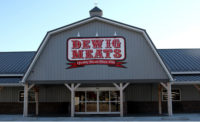Making the Cut
By Tom Wray, Associate Editor
Suppliers adapt to customer tastes and changing needs with new equipment
Poultry is a popular meat for American consumers. But the size of chickens and the bones can create challenges in automated processing and portioning. Fortunately, companies are always working on new equipment to meet those challenges.
“The irregular shapes pose challenges for slicing equipment, as does the sinewy composition of raw poultry,” says Andy Schneider of Grote Company.
Jeff Ray of Marel Food Systems says the demands of the market for poultry products also require specific shapes, weights and serving sizes. The different shapes and sizes of each chicken part also play a role.
Gwen Venable of Stork Food Systems says, “Depending on customer specifications, different parts of the poultry need different techniques. The technique used ultimately depends upon the customer’s specifications.”
Portioning does help add value to poultry products.
“Some reasons to portion are higher yields and labor savings,” says Venable. “From a consumer standpoint, it saves time as a butcher is no longer needed.”
It is a size-versus-market value perception, according to Dale Stoltzfus, vice president of sales at Meyn America LLC. When a consumer goes to the store, he or she wants value for the price.
As chicken raising practices have advanced, the chickens themselves have gotten bigger. That adds an additional challenge.
“The birds’ weight directly influences the system it is being processed on,” explains Venable. “Also, the request for faster systems is a challenge.”
There are also changing product lines with processors, says Jan Gaydos, director of market services for FMC Foodtech. In a fast-moving market, companies will create new recipes and cuts to keep ahead of the competition.
“Our customers are continually adding new products to their mix,” Gaydos says. “This requires a high degree of flexibility to adapt to new requirements.”
Venable used the example of one of her company’s portioning systems as an example of this need. Stork’s ACM-NT allows for creating eight- and nine-piece fast-food cuts. The cuts have to match specific requirements in size and eight to meet the demands of fast food and those of retail and other foodservice outlets.
“Poultry producers have been able to select and process available broilers in such a way that optimal marketable products can be produced,” she says.
Changing technology
The industry is adapting to these changing needs as they design and build equipment.
Gaydos says the newest developments have been in software enhancements with the equipment and the ability to portion multiple products from a single butterfly breast based on its size. He also says that future plans include the ability to produce more high-value products with less low value trim through improvements in software and sorting.
He also says information is important. “The collection and use of statistical process control is increasingly important for improving consistency, quality and productivity,” Gaydos explains.
His company, FMC FoodTech, offers a software product called Link Process Analysis that gathers both process and product parameters and uses and SPC packages.
For Grote Company, the newest development is the LSS-2 Linear Steak & Poultry Splitter. The machine is designed to cut whole-muscle products lengthwise and split them into two pieces. It uses a band-blade to split of product of any length and up to three inches in height. It has single- and dual-infeed convey systems and cutting zones of up to 10 inches per lane.
Marel also has new products out to serve the market. The Scanvaegt ScanPortioner B22 from Marel is also a dual-lane portion cutter. The machine is designed specifically for poultry processors. It uses a servo-driven knife in each lane and a high-speed laser vision system to maintain accuracy.
The cutter is also flexible. It can switch back and forth between different cutting angles, allowing for the achievement of a natural look with products such as fixed-weight chicken breasts. It also has a speed of up to 1,500 cuts per lane per minute.
The Marel TSM Profiler uses a template to cut poultry filets or butterflies in to uniform portions of a specified weight and shape. The machine uses unfrozen breast meat that is larger than the end product. The breasts fill and cover the template itself in order meet the specifications. There are various templates for different processing needs and new ones can be made to order. It has a capacity of 1,215 pounds per hour in production.
Marel’s Ray says that automatic loading of portioners and shape cutting equipment are a couple of features on the horizon for equipment.
Stork Food Systems’ newest systems include a front half deboning system and a flexible portioning system.
The FHF-XB debones front halves into skin-on or skinless fillets. The machine can have through puts of up to 3,600 front halves per hour with six operators. Venable says the system processes fillets with or without skin, whole outer fillets with back and shoulder meat, tenderloins with or without tendons, whole wings, inner wing joints only or outer fillets with wings attached.
The ACM-NT can do portioning at speeds up to 7,200 birds per hour. Whole products fed into the system are then cut in to various portions. It has a transport system that conveys the portions to different modules for further processing.
The company also offers modules for wing processing. Module CC performs anatomic cutting in the joint of the whole wing and/or the first wing member without any breast meat. Wing cutting module CC-HY has the same capabilities as the CC type but is also capable of harvesting additional meat from the back. Module CC-F/KFC cuts the whole wing and the first wing member from the carcass, with a surplus of breast meat attached to the joint. The second-joint wing cutting module cuts the wing between the first and second wing members, with or without wing tips. The wing tip cutting module cuts the wing tip so that an anatomic cut is affected in the joint, thus ensuring a maximum of retained wing meat.
Gainco’s contribution to the field is the GS-2500. This machine is designed the maintain productivity while keeping the incidence of overweight packing and product giveaway to a minimum. Gainco’s portion sizing equipment features a sizing speed of up to 180 portions per minute with a tolerance of plus or minus 0.5 gram, depending on product size and stability.
The portion sizing part of the GS-2500 has local (machine-mounted) or remote (office-mounted) controller configurations available, incorporating the Windows interface screen format. It has a larger, easy-to-read display monitor allows the viewing of all drops at one time. The hardware is designed with Intralox plastic conveyor belting and can be easily disassembled for sanitation. The modular system design is components.
For AEW Delford, the ShapeLine Compact is the entry. The machine is the latest addition to the ShapeLine portion shaping range. This magazine loaded, high-capacity shaping machine produces portions of the required shape and texture, in three dimensions, from the frozen state.
The machine has been developed specifically for processors who need to respond to the growing demand for portion controlled poultry products with a natural appearance and texture. ShapeLine Compact works with frozen natural fillet or whole-muscle product without the need for thawing, grinding or further processing.
ShapeLine Compact can produce one, two or three shaped portions per machine cycle. Portions with different shapes can be produced to give pack variety and cavity portions for sauces or fillings can also be shaped. Nuggets are also an option.
Marlen Research has the C.O.V. Portioner. The portioner is applicable to portioning three- to 52-pound quantities into bags and chubs. It volumetrically measures the whole muscle, section/form or ground product, then delivers it at a controlled rate to the package. Coupled with a Marlen pump, the C.O.V. can deliver up to 20 portions per minute.
The company also offers the V.P. 300 Portioner. It uses reciprocal action; as one side fills, the other discharges. Typically, the V.P. 300 can be applied to portion ranges between four ounces and five pounds. The V.P. 300 is capable of delivering up to 50 portions per minute, depending on portion size.
The R.S. Portioner, also from Marlen, is designed to volumetrically measure and deliver specific portions into rollstock packaging machines. It measures, then rotates to deliver into the package. Weights up to 15 pounds are feasible.
Prime Equipment Group has the PC-1 Portion Cutter. It can portion breast meat, tenders and dark meat to specific weights and shapes. It can do 23 whole breasts a minute or up to 100 chicken tenders per minute.
Meat slicers from Ross Industries also have many features for portioning. The company states that its models have features such as variable slice and conveyor speed adjustments, which enable operators to match slicer performance to process requirements. They can also operate at a minimum of 200 slices per minute. The products are positioned in vertical stationary chutes and gravity fed into a slicing area. The slice thickness is adjustable, even during operation.



Report Abusive Comment